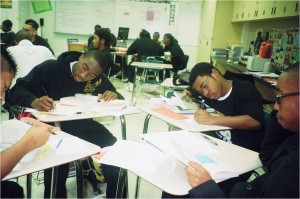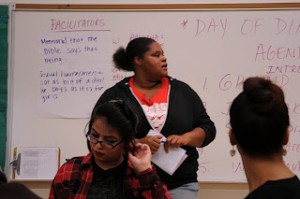The War Against Black Children
In a predominantly Black South L.A. continuation school class packed with eleventh and twelfth grade girls, only half want to go to college, few can name role models of color and virtually none have been exposed to literature by women of color. Demonized as the most expendable of the expendable, Black continuation school students are routinely branded as too “at risk”, “challenged” and “deficit-laden” to be “college material”. Coming from backgrounds of abuse, incarceration, foster care and homelessness, these youth are already written off as budding welfare queens and baby mamas. They are at the epicenter of the war against Black children.
State-sanctioned terrorism against Black children is commonly understood as murder, harassment, and racial profiling–overt acts of violence which elicit marches, pickets, mass resistance and moral outrage. Last week, Republicans and Democrats alike fell all over themselves to commemorate the 50th anniversary of the tragic murder of four African American girls in the 16th Street Church bombing in Birmingham, Alabama. Such overt acts of organized white supremacist terrorism against Black children have largely receded. Instead, they have been replaced by the socially acceptable state violence of school-to-prison pipelining, racist low expectations and the illusion of equal educational opportunity in the “post Jim Crow” era of re-segregated schools.
Last spring, in an offensive commencement speech to Morehouse College graduates, President Obama launched into his standard refrain about personal responsibility, sagging pants and absent fathers. Checking shiftless Black youth has long been one of his favorite presidential past-times. As progressive Black pundits have noted, this narrative not only plays well in Peoria, but on the global stage. For a nation brainwashed into believing the U.S. is an exceptionalist beacon, the underachievement of black students has become both shorthand for and explanation of its low standing in academic rankings. According to this view, the achievement gap between (lazy) Black and (enterprising) white and Asian students “drags” down the U.S.’ global academic standing. Steeped in a culture of pathology, native-born African American youth “squander” the opportunities seized upon by newly arrived immigrant students of color.
As a 2013 high school graduate and first generation college student of mixed heritage, Ashley Jones is well acquainted with toxic anti-black propaganda. She says, “Being Black and Thai…if I do well on a test or in class, then some people will comment, ‘that’s your Asian side.’” Jones comes from a South L.A. school where it is not uncommon for teachers to reflexively track students into college prep, honors and Advanced Placement (AP) classes according to race and ethnicity. She comments, “If you were to ask these same people about race, they would tell you we are all equal and anyone can achieve anything they set their mind to, but when you listen to them talk at nutrition and lunch, you hear Blackness constantly associated with violence, ‘being ghetto’, and a lack of intellectual abilities.” A recent L.A. Times article about Kashawn Campbell, a high-achieving African American graduate of South L.A.’s Jefferson High School who struggled to get C’s and D’s at UC Berkeley, exemplifies these sentiments. The over 700 responses on the article’s comment thread were relentless: the young man’s plight was due to inflated expectations, laziness, outright sloth, and the natural intellectual inferiority of African Americans. Even the National Review picked up the piece and dubbed it an example of a “Devastating Affirmative Action Failure.” Why, many commenters howled contemptuously, didn’t Campbell’s slot go to a “real” achiever, i.e., a hardworking Asian or white student who genuinely deserved it? Missing from the near universal condemnations of affirmative action was the fact that Campbell’s freshman performance at UC Berkeley reflects the deficits of a neo-liberal public education system in which even high achieving students of color may be grossly underprepared for college work. High stakes tests, unqualified teachers, culturally un-responsive curricula, overcrowded classrooms, long term subs, high student-to-college counselor ratios and school climates that over-suspend, criminalize and push-out Black and Latino youth all influence whether a student thrives or languishes in a rigorous college environment. According to the Education Trust West, “Only one of every 20 African American kindergartners will graduate from a four-year California university if (these) current trends continue.”
Yet the myth of the lazy Black student, mascot of a shiftless pathological culture, remains a powerful theme in anti-public education and anti-affirmative action propaganda. Last week, the U.S. Department of Education’s Office of Civil Rights (OCR) entered into an agreement with several Alabama school districts to redress the underrepresentation of African American students in advanced, honors and AP course enrollment (as well as test-taking). The OCR found that advanced math was offered in the seventh grade at white middle schools, but wasn’t offered at predominantly African American middle schools. AP courses are gatekeepers to top colleges and universities. A high score on an AP test allows a student to receive college course credit. Nationwide, African American students are less likely to be enrolled in AP classes, especially the “elite” math and science courses that are virtually required for admission to top STEM (science, technology, engineering and mathematics) programs. At 14% of the U.S. student population Black students comprise only 3% of those enrolled in AP courses or taking AP exams. According to the College Board, “The vast majority of Black high school graduates from the Class of 2011 who could have done well in an AP course never enrolled in one because they were either ‘left out’ or went to a school that didn’t offer the college prep courses.” Persistently racist attitudes about the academic and intellectual capacity of black students are a major barrier to their placement in AP and college prep courses. In schools with diverse multicultural populations Black students are still routinely consigned to less challenging courses (even if they have high GPAs) and stereotyped as not being as capable as other students of color.
As one private college counselor argues, “With competition for college admission increasing every year, many students fear they won’t be accepted without five or six AP courses, and when it comes to the most selective colleges, they are probably right.” Eighty three percent of colleges ranked grades in college prep courses as the single most important factor in their admissions decisions. According to the OCR, “enrollment in middle school advanced math courses – and, in particular, in 8th grade Algebra—sets students on the path for completion of the District’s highest level course offerings in math and science, including AP courses.”
Nationwide, African American students struggle with and are underrepresented in eighth grade Algebra courses. In Silicon Valley, fount of American technological innovation, fewer than 25% of black and Latino students successfully complete Algebra. Moreover, only 20% of Latinos and 22% of African-Americans “graduate with passing grades in the courses that are required” for admission to UC and Cal State universities. Ultimately, the predominantly white and Asian make-up of Silicon Valley companies reflects the insidious ramifications of these disparities. Passing Algebra is a major predictor of later success in college. But if students of color don’t have access to college prep math in middle school (and then transition to high school taking less rigorous courses), gaining admission to and staying in college, much less graduating from college, will never be a viable option.
Despite the mainstreaming of discourse about “diversity” and culturally responsive teaching, there is little focus on the unrelenting violence anti-black racism inflicts upon even high-achieving Black students. The vitriol expressed toward UC Berkeley student Kashawn Campbell reflects the rawness of mainstream views about the moral failings of all Black students. Here, “even” high-achieving Black students are presumed to be “guilty” representatives of communities that reject presumably accepted “American” standards for academic success and personal uplift. Exceptional Black folk may delude themselves into believing that they can successfully manipulate this equation in their favor. But Obama’s destructive Talented Tenth palliatives merely reflect this nation’s deep investment in violence against Black children.
Sikivu Hutchinson is the author of Godless Americana: Race and Religious Rebels and Moral Combat: Black Atheists, Gender Politics and the Values Wars. She is also the founder of the Women’s Leadership Project, a feminist mentoring program based in South Los Angeles.



2 Comments